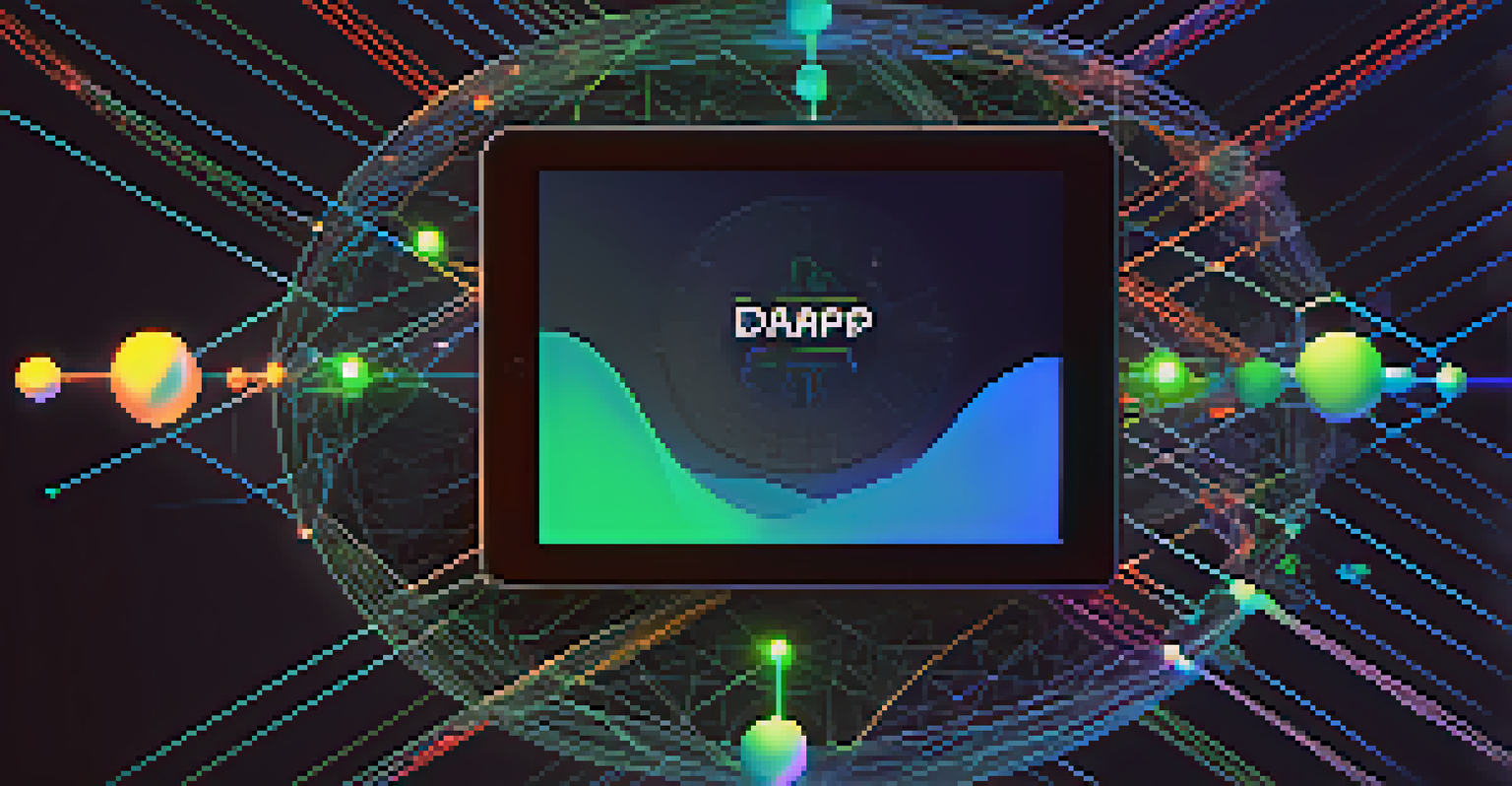Bitcoin Layer 2 Solutions: Enhancing dApp Functionality

Understanding Bitcoin Layer 2 Solutions
Bitcoin Layer 2 solutions are built on top of the Bitcoin blockchain to improve its scalability and efficiency. They are necessary because the Bitcoin network, while secure, can become congested and slow during peak usage times. By creating a secondary layer, these solutions facilitate faster transactions and lower fees, making Bitcoin more appealing for everyday use.
Bitcoin is a technological tour de force.
One of the most well-known Layer 2 solutions is the Lightning Network, which allows users to create payment channels that enable instant transactions off the main blockchain. This means that multiple transactions can occur without each one being recorded on the blockchain, reducing the load on the network. Think of it like a busy highway where carpool lanes help ease traffic—everyone gets to their destination faster.
As Layer 2 solutions gain traction, they open up new possibilities for decentralized applications (dApps) that rely on quick, inexpensive transactions. This enhanced functionality is essential for developers aiming to create user-friendly applications that can compete with traditional financial systems.
The Role of dApps in the Bitcoin Ecosystem
Decentralized applications, or dApps, are software programs that run on a blockchain rather than a centralized server. They have gained popularity due to their ability to offer transparency and security, appealing to users who value privacy and control over their data. With Bitcoin's Layer 2 solutions, dApps can leverage faster transaction speeds and lower costs, making them more accessible to a broader audience.

Imagine dApps as your favorite apps, like social media or banking, but with the added benefits of decentralization. Instead of relying on a single company to manage user data and transactions, dApps distribute control among users, reducing the risk of hacks or data breaches. Layer 2 solutions enhance this experience by ensuring that interactions remain swift and seamless.
Speeding Up Bitcoin Transactions
Layer 2 solutions significantly increase transaction speeds, enabling almost instant transactions for applications requiring real-time interactions.
By integrating Layer 2 technology, developers can build dApps that provide real-time services, such as microtransactions or instant trading. This opens up new avenues for innovation, allowing users to engage with their favorite applications without the frustration of long wait times or high fees.
How Layer 2 Solutions Improve Transaction Speed
One of the primary advantages of Bitcoin Layer 2 solutions is their ability to significantly increase transaction speed. Traditional Bitcoin transactions can take several minutes, especially during high network demand, but Layer 2 solutions can enable almost instant transactions. This speed is crucial for applications that require real-time interactions, like gaming or trading platforms.
The future of money is digital currency.
To illustrate, consider a busy coffee shop where customers are ordering drinks. If each order takes time due to a long line, customers will get frustrated. However, if the shop implements a mobile ordering system (akin to Layer 2), customers can place their orders instantly without waiting in line. This is similar to how Layer 2 solutions help manage Bitcoin transactions efficiently.
With faster transactions, dApps can offer an enhanced user experience, allowing for more engaging and interactive features. Users can send and receive funds, participate in games, or trade assets without the dreaded lag time, making the applications much more enjoyable and efficient.
Reducing Transaction Costs with Layer 2 Solutions
Another significant benefit of Bitcoin Layer 2 solutions is the reduction in transaction costs. On the main Bitcoin network, fees can spike during busy periods, making small transactions less viable. Layer 2 solutions alleviate this issue by enabling off-chain transactions that don’t require the same fees as on-chain transactions.
Imagine trying to send a small amount of money to a friend using traditional banking methods—transaction fees can often be higher than the amount being sent! Layer 2 solutions help avoid this pitfall by allowing microtransactions to occur at a fraction of the cost, making it feasible for users to engage in small payments without worrying about fees.
Lowering Costs for Users
By facilitating off-chain transactions, Layer 2 solutions reduce transaction fees, making small payments more viable and accessible.
This reduction in costs is particularly beneficial for developers looking to create applications that rely on frequent, low-value transactions, such as tipping or in-app purchases. By making these interactions cheaper, Layer 2 solutions help foster a more vibrant ecosystem of dApps that can cater to a diverse range of user needs.
Enhancing Security in dApps with Layer 2 Solutions
Security is a paramount concern in any digital application, especially in the cryptocurrency space. Bitcoin’s Layer 2 solutions enhance security by maintaining the core features of the Bitcoin blockchain while allowing for secure off-chain transactions. This means that even while using Layer 2, users can still benefit from the strong security protocols that Bitcoin is known for.
Think of it like a bank vault—while transactions can occur outside the vault, the security of the contents remains intact. Layer 2 solutions ensure that users can transact freely and quickly without compromising the overall integrity of their assets. This is crucial for dApps that handle sensitive information or large amounts of value.
Moreover, the use of smart contracts in Layer 2 solutions adds an additional layer of security by automating processes and reducing the chances of human error. This means that dApps can operate with increased trust and reliability, making them more appealing to users concerned about the safety of their funds.
Real-World Use Cases of Bitcoin Layer 2 Solutions
Real-world applications of Bitcoin Layer 2 solutions are already emerging, showcasing their potential to revolutionize various industries. For instance, companies are utilizing the Lightning Network to enable instant payments for goods and services, allowing customers to complete transactions quickly and efficiently. This is particularly valuable in fast-paced environments like retail, where time is money.
Additionally, gaming platforms are leveraging Layer 2 solutions to facilitate in-game purchases and rewards. Instead of waiting for transactions to process on the main chain, players can enjoy instant interactions, enhancing their overall gaming experience. It’s like having a cheat code that lets you skip to the fun parts without the wait.
Enhancing dApp Security
Layer 2 solutions maintain Bitcoin's robust security while allowing for secure off-chain transactions, making dApps safer for users.
These use cases highlight how Layer 2 solutions can be integrated into various sectors, from e-commerce to entertainment. As more developers adopt these technologies, we can expect to see an explosion of innovative dApps that capitalize on the speed, cost-effectiveness, and security that Layer 2 provides.
The Future of Bitcoin Layer 2 and dApp Integration
The future of Bitcoin Layer 2 solutions looks promising as more developers recognize their potential for enhancing dApp functionality. With ongoing improvements in technology and increased adoption, we can expect to see a wave of new applications that harness the benefits of faster transactions and lower costs. This will likely lead to a more robust ecosystem of dApps that cater to the growing needs of users.
As the landscape evolves, it’s crucial for developers to stay informed about the latest advancements in Layer 2 technology. This will enable them to build innovative applications that not only meet user demands but also push the boundaries of what’s possible in the blockchain space. Just like any cutting-edge technology, the key is to embrace change and adapt.

In conclusion, Bitcoin Layer 2 solutions are set to play a pivotal role in the future of decentralized applications. By enhancing speed, security, and cost-effectiveness, these solutions will help shape the next generation of dApps, making them more accessible and functional for users around the globe.